A Simplified Guide to Fingerprint Analysis
Introduction
We touch things every day: a coffee cup, a car
door, a computer keyboard. Each time we do, it
is likely that we leave behind our unique
signature—in our fingerprints.
No two people have exactly the same
fingerprints. Even identical twins, with
identical DNA, have different fingerprints. This
uniqueness allows fingerprints to be used in all
sorts of ways, including for background checks,
biometric security, mass disaster
identification, and of course, in criminal
situations.
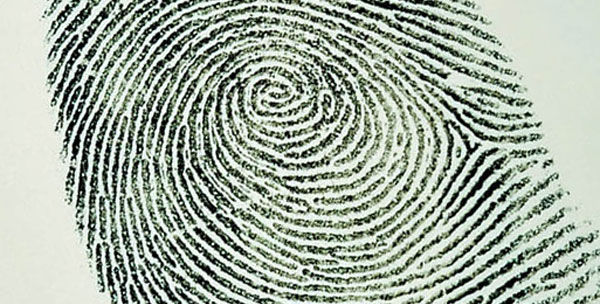
Fingerprint analysis has been used to identify
suspects and solve crimes for more than 100
years, and it remains an extremely valuable tool
for law enforcement. One of the most important
uses for fingerprints is to help investigators
link one crime scene to another involving the
same person. Fingerprint identification also
helps investigators to track a criminal’s
record, their previous arrests and convictions,
to aid in sentencing, probation, parole and
pardoning decisions.
Principles of Fingerprint Analysis
Fingerprints are unique patterns, made by friction ridges (raised) and furrows
(recessed), which appear on the pads of the fingers and thumbs. Prints from
palms, toes and feet are also unique; however, these are used less often for
identification, so this guide focuses on prints from the fingers and thumbs.
The fingerprint pattern, such as the print left when an inked finger is pressed
onto paper, is that of the friction ridges on that particular finger. Friction
ridge patterns are grouped into three distinct types—loops, whorls, and
arches—each with unique variations, depending on the shape and relationship of
the ridges:
Loops - prints that recurve back on themselves to form a loop shape.
Divided into radial loops (pointing toward the radius bone, or thumb) and ulnar
loops (pointing toward the ulna bone, or pinky), loops account for approximately
60 percent of pattern types.

Whorls - form circular or spiral patterns, like tiny whirlpools. There
are four groups of whorls: plain (concentric circles), central pocket loop (a
loop with a whorl at the end), double loop (two loops that create an S-like
pattern) and accidental loop (irregular shaped). Whorls make up about 35 percent
of pattern types.
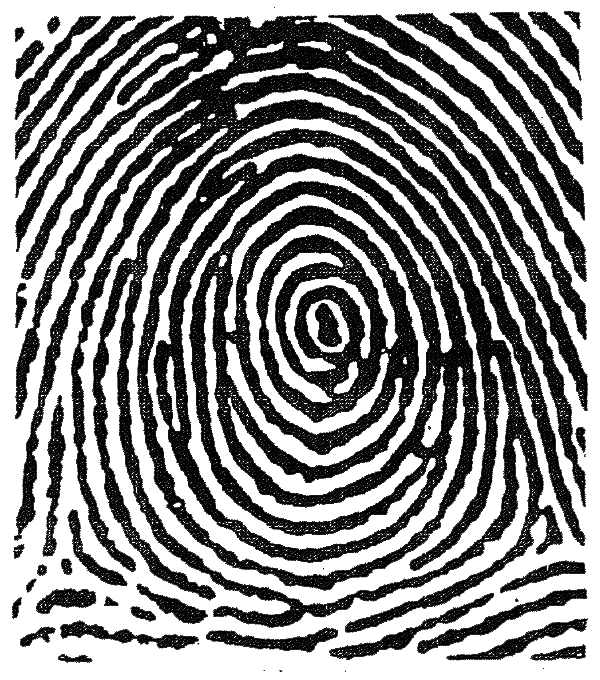
Arches - create a wave-like pattern and include plain arches and tented
arches. Tented arches rise to a sharper point than plain arches. Arches make up
about five percent of all pattern types.

To Each His Own
The two underlying premises of fingerprint identification are uniqueness and
persistence (permanence). To date, no two people have ever been found to have
the same fingerprints—including identical twins. In addition, no single person
has ever been found to have the same fingerprint on multiple fingers.
Persistence, also referred to as permanence, is the principle that a person’s
fingerprints remain essentially unchanged throughout their lifetime. As new skin
cells form, they remain cemented in the existing friction ridge and furrow
pattern. In fact, many people have conducted research that confirms this
persistency by recording the same fingerprints over decades and observing that
the features remain the same. Even attempts to remove or damage one’s
fingerprints will be thwarted when the new skin grows, unless the damage is
extremely deep, in which case, the new arrangement caused by the damage will now
persist and is also unique.
The Proof is in the Minutiae
Analysts use the general pattern type (loop, whorl or arch) to make initial
comparisons and include or exclude a known fingerprint from further analysis. To
match a print, the analyst uses the minutiae, or ridge characteristics, to
identify specific points on a suspect fingerprint with the same information in a
known fingerprint. For example, an analyst comparing a crime scene print to a
print on file would first gather known prints with the same general pattern
type, then using a loupe, compare the prints side-by-side to identify specific
information within the minutiae that match. If enough details correlate, the
fingerprints are determined to be from the same person.
When and when is fingerprint analysis used?
Fingerprints can be used in all sorts of ways:
-
1.
Providing biometric security (for example, to control access to
secure areas or systems)
-
2.
Identifying amnesia victims and unknown deceased (such as
victims of major disasters, if their fingerprints are on file)
-
3. Conducting background checks (applications for
government employment, defense security clearance, concealed
weapon permits, etc.).
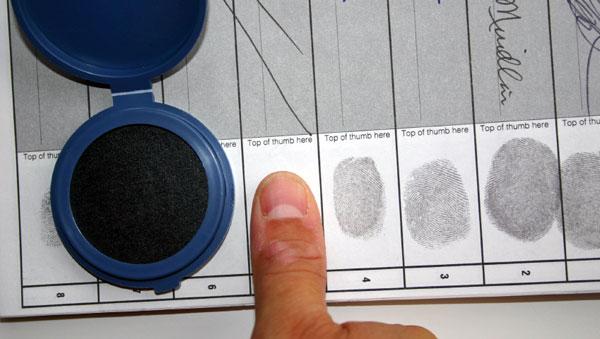
Fingerprints are especially important in the criminal justice realm.
Investigators and analysts can compare unknown prints collected from a crime
scene to the known prints of victims, witnesses and potential suspects to assist
in criminal cases. For example:
-
1.
A killer may leave their fingerprints on the suspected murder
weapon
-
2.
A bank robber’s fingerprints may be found on a robbery note
-
3.
In an assault case, the perpetrator may have left fingerprints
on the victim’s skin
-
4.
A burglar may leave fingerprints on a broken window pane
-
5.
A thief’s fingerprints may be found on a safe
In addition, fingerprints can link a perpetrator to other unsolved crimes if
investigators have reason to compare them, or if prints from an unsolved crime
turn up as a match during a database search. Sometimes these unknown prints
linking multiple crimes can help investigators piece together enough information
to zero in on the culprit.
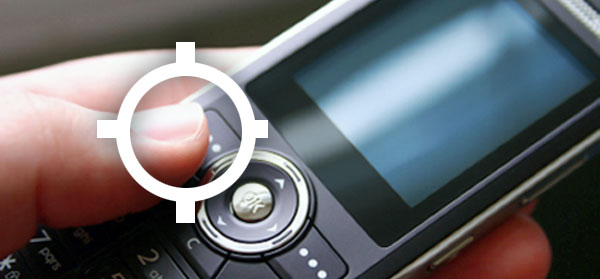
In the absence of DNA, fingerprints are used by the criminal justice system to
verify a convicted offender’s identity and track their previous arrests and
convictions, criminal tendencies, known associates and other useful information.
Officers of the court can also use these records to help make decisions
regarding a criminal’s sentence, probation, parole or pardon.
How It’s Done
Where Fingerprints May be Found
Fingerprints can be found on practically any solid surface, including the human
body. Analysts classify fingerprints into three categories according to the type
of surface on which they are found and whether they are visible or not:
Fingerprints on soft surfaces (such as soap, wax, wet paint, fresh caulk, etc.)
are likely to be three-dimensional plastic prints; those on hard surfaces are
either patent (visible) or latent (invisible) prints. Visible prints are formed
when blood, dirt, ink, paint, etc., is transferred from a finger or thumb to a
surface. Patent prints can be found on a wide variety of surfaces: smooth or
rough, porous (such as paper, cloth or wood) or nonporous (such as metal, glass
or plastic).
Latent prints are formed when the body’s natural oils and sweat on the skin are
deposited onto another surface. Latent prints can be found on a variety of
surfaces; however, they are not readily visible and detection often requires the
use of fingerprint powders, chemical reagents or alternate light sources.
Generally speaking, the smoother and less porous a surface is, the greater the
potential that any latent prints present can be found and developed.
How Fingerprints are Collected
Collecting Patent Prints
Patent prints are collected using a fairly straightforward method: photography.
These prints are photographed in high resolution with a forensic measurement
scale in the image for reference. Investigators can improve the quality of the
images by using low-angle or alternate light sources and/or certain chemicals or
dyes during photography, but this is usually not necessary.
Collecting Latent Prints
One of the most common methods for discovering and collecting latent
fingerprints is by dusting a smooth or nonporous surface with fingerprint powder
(black granular, aluminum flake, black magnetic, etc.). If any prints appear,
they are photographed as mentioned above and then lifted from the surface with
clear adhesive tape. The lifting tape is then placed on a latent lift card to
preserve the print.
However, fingerprint powders can contaminate the evidence and ruin the
opportunity to perform other techniques that could turn up a hidden print or
additional information. Therefore, investigators may examine the area with an
alternate light source or apply cyanoacrylate (super glue) before using powders.
Alternate Light Source (ALS)
It is becoming more commonplace for
investigators to examine any likely surfaces (doors, doorknobs, windows,
railings, etc.) with an alternate light source. These are laser or LED devices
that emit a particular wavelength, or spectrum, of light. Some devices have
different filters to provide a variety of spectra that can be photographed or
further processed with powders or dye stains. For example, investigators may use
a blue light with an orange filter to find latent prints on desks, chairs,
computer equipment or other objects at the scene of a break-in.

Using a fluorescent dye stain and an orange alternate light source helps this
latent print appear clearly so that it can be documented. (Courtesy of Scott
Campbell, Ron Smith & Associates)

Use of various alternate light sources may help enhance the appearance of a
fingerprint. (Courtesy of Scott Campbell, Ron Smith & Associates)
Cyanoacrylate
Investigators often perform cyanoacrylate (superglue)
processing, or fuming, of a surface before applying powders or dye stains. This
process, typically performed on non-porous surfaces, involves exposing the
object to cyanoacrylate vapors. The vapors (fumes) will adhere to any prints
present on the object allowing them to be viewed with oblique ambient light or a
white light source.

A chamber specially designed for exposing latent prints to super glue fumes.
(Courtesy of Scott Campbell, Ron Smith & Associates)

Super glue fumes adhere to latent fingerprints on the neck of a glass bottle.
(Courtesy of Scott Campbell, Ron Smith & Associates)
Chemical Developers
Porous surfaces such as paper are typically
processed with chemicals, including ninhydrin and physical developer, to reveal
latent fingerprints. These chemicals react with specific components of latent
print residue, such as amino acids and inorganic salts. Ninhydrin causes prints
to turn a purple color, which makes them easily photographed. DFO
(1,2-diazafluoren-9-one) is another chemical used to locate latent fingerprints
on porous surfaces; it causes fingerprints to fluoresce, or glow, when they are
illuminated by blue-green light.
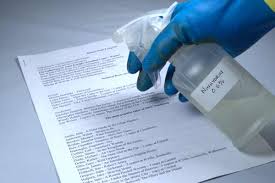
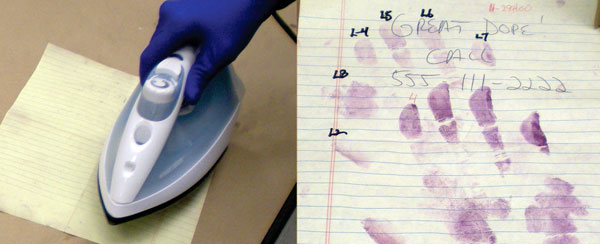
Paper treated with ninhydrin reagent reveals latent prints after being processed
with a household steam iron. (Courtesy of NFSTC)
Other Collection Methods
In addition to the methods identified above,
there are special techniques for capturing prints from skin, clothing and other
difficult surfaces. Amido Black, a non-specific protein stain that reacts with
any protein present, is typically used for developing or enhancing bloody
impressions on human skin. To reveal prints on clothing, high-tech methods such
as vacuum metal deposition using gold and zinc are showing promise for the
investigator. AccuTrans®, a liquid casting compound, can be used to lift
powdered latent prints from rough, textured or curved surfaces. AccuTrans® is
basically a very thick liquid that fills in the nooks and crannies of rough or
textured areas where conventional print lifting tape encounters difficulty.
Like fingerprint powders, chemical processing can reduce the investigator’s
ability to perform other techniques that could reveal valuable information.
Therefore, any nondestructive investigations are performed before the evidence
is treated with chemicals. For example, a ransom or hold-up note will be
examined by a questioned documents expert before being treated with ninhydrin,
since some formulations of ninhydrin will cause certain inks to run, thus
destroying the writing.
Who Conducts the Analysis
In criminal justice cases, computerized systems are used to search various
local, state and national fingerprint databases for potential matches. Many of
these systems provide a value indicating how close the match is, based on the
algorithm used to perform the search. Fingerprint examiners then review the
potential matches and make a final determination.
Fingerprint examinations may be conducted by forensic scientists, technicians or
police officers; however, the examiner should have the proper training and
experience to perform the task. Currently many agencies require new examiners to
have a four-year degree in science (biology, chemistry or physics). In addition,
agencies may require examiners to become certified by the International
Association for Identification (IAI). IAI’s
website provides certification requirements.
How and Where the Analysis is Performed
Fingerprint analysis is usually performed by law enforcement agencies or crime
laboratories; however, casework may be sent to private companies if there is a
need, such as to reduce backlogs, verify results, or handle high-profile cases.
Fingerprint examination involves looking at the quality and quantity of
information in order to find agreement or disagreement between the unknown print
(from the crime scene) and known prints on file. To conduct the examination,
fingerprint examiners use a small magnifier called a loupe to view minute
details (minutiae) of a print. A pointer called a ridge counter is used to count
the friction ridges.
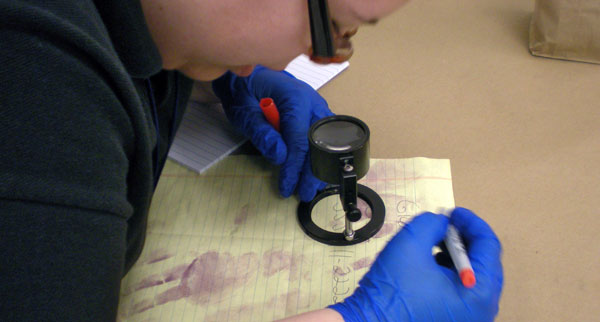
An examiner uses a loupe to view minute details of a fingerprint. (Courtesy of
NFSTC)
The Fingerprint Analysis Process
Fingerprint examiners use the ACE-V (analysis, comparison, evaluation and
verification) method to reach a determination on each print.
1. "A" for Analysis
Involves assessing a print to determine if it can be used for
a comparison. If the print is not suitable for comparison because of inadequate
quality or quantity of features, the examination ends and the print is reported
as not suitable. If the print is suitable, the analysis indicates the features
to be used in the comparison and their tolerances (the amount of variation that
will be accepted). The analysis may also uncover physical features such as recurves, deltas, creases and scars that help indicate where to begin the
comparison.
2. "C" for Comparisons
Comparisons are performed by an analyst who views the known and suspect
prints side-by-side. The analyst compares minutiae characteristics and locations
to determine if they match. Known prints are often collected from persons of
interest, victims, others present at the scene or through a search of one or
more fingerprint databases such as the FBI’s Integrated Automated Fingerprint
Identification System (IAFIS). IAFIS is the largest fingerprint database in the
world and, as of June 2012, held more than 72 million print records from
criminals, military personnel, government employees and other civilian
employees.
3. "E" for Evaluation
The evaluation process involves the examiner ultimately decides if the prints are
from the same source (identification or individualization), different sources
(exclusion) or is inconclusive. Inconclusive results may be due to poor quality
samples, lack of comparable areas, or insufficient number of corresponding or
dissimilar features to be certain.
4. "V" for Verification
Verification involves having another examiner independently analyze, compare
and evaluate the prints to either support or refute the conclusions of the
original examiner. The examiner may also verify the suitability of
determinations made in the analysis phase.
FAQs
Each fingerprint examination will result in one of the following
conclusions:
-
The fingerprint was made by
(identified/individualized to) a known source
(victim, suspect, etc.)
-
The fingerprint was not made by (excluded to) a
known source.
-
The fingerprint cannot be identified or excluded
to a known source (inconclusive).
-
The fingerprint is of no value to compare (not
suitable for comparison) to a known source.
Perhaps the primary limitation of fingerprint analysis is that
there must be a known print that can be compared to the
collected print. Unless there is a known suspect or the
perpetrator’s prints are found on file in one of the many
databases around the world, the collected prints will likely
only be used to exclude individuals from the investigation.
Another limitation is that there is no scientific way to
determine the time a latent print was deposited on a surface. An
examiner cannot tell how long a print has been on a surface or
under what circumstances it was placed there. For example, if a
suspect’s print is found in the kitchen of a murdered
acquaintance, the print may or may not be tied to the murder,
especially if the suspect claims to have visited the victim’s
house fairly recently.
It is not possible to determine sex, age or race from a latent
print; if sufficient DNA is left behind, then the party’s sex
can be determined. Learn
more about DNA
To ensure the most accurate analysis of evidence, the management
of forensic laboratories puts in place policies and procedures
that govern facilities and equipment, methods and procedures,
and analyst qualifications and training. Depending on the state
in which it operates, a crime laboratory may be required to
achieve accreditation to verify that it meets quality standards.
There are two internationally recognized accrediting programs
focused on forensic laboratories: The
American Society of Crime Laboratory Directors Laboratory
Accreditation Board and ANSI-ASQ
National Accreditation Board / FQS.
In disciplines such as fingerprint examination, where testing
requires analysts to compare specific details of two samples,
quality control is achieved through technical review and
verification of conclusions. This involves an expert or peer who
reviews the test data, methodology and results to validate or
refute the outcome. The Scientific Working Group on Friction
Ridge Analysis, Study and Technology (SWGFAST) publishes
quality assurance standards for use by forensic practitioners.
These standards indicate that all identifications must be
verified, whereas exclusions and inconclusive results should be
verified. This involves having an expert or peer review the test
data, methodology and results to validate or refute the outcome.
Reports typically will state what evidence was received, what
types of examinations were conducted and the results of those
examinations. Results should be worded clearly so that the end
user has no difficulty in understanding the results (see “What
kind of results should I expect?” above).
Once the examiner has completed their analysis and reached a
conclusion, there is no interpretation required. Results clearly
fall into one of the four categories.
Just because someone touches a surface does not guarantee that a
latent print will be deposited. Here are some reasons a print
may not be deposited:
-
The person may be wearing gloves.
-
The person’s hands may be very dry, which means
there is little or no sweat or oils coating the
ridges. Therefore, the ridge detail won’t
reliably transfer to the surface.
-
Rougher surfaces are less conducive to receiving
latent impressions than smooth surfaces.
Even if a print is deposited, it may not become a useful piece
of evidence. Here are some reasons why:
-
It may not be discovered.
-
It may not survive, due to environmental
factors. For example, prints deposited outdoors
in arid climates may not survive long because
latent print residue is approximately 98% water.
-
If a particular surface or item is
collected/packaged improperly, any latent prints
may be destroyed.
-
The print may be found but not contain a
sufficient amount of information to be useful.
For example, it could be a partial print, a
smeared print, or from a part of the hand for
which a known print is not available.
Common Terms
The Scientific Working Group on Friction Ridge Analysis, Study and Technology
(SWGFAST) maintains a list of terms generally used and accepted within the
fingerprint analysis community. Additional terms can be found on the SWGFAST
website .
Arch, plain - A type of print pattern in which the friction ridges
enter on one side of the print and flow out the other side with a rise or wave
in the center.
Arch, tented - A type of print pattern similar to the plain arch but
that possesses an angle, upthrust (central rise), or two of the three basic
characteristics of the loop.
Cyanoacrylate - The primary (>98%) component of super glue; it is used
in a fuming technique to develop latent (invisible) prints on a variety of
surfaces so they can be photographed.
Core - A structure in the print that is the center line or lines of the
print; it is important for conducting ridge counts.
Delta - A point in loop and whorl prints that lies within an often
triangular, three-pronged or funnel-shaped structure; it is the part of a ridge
nearest the point where two parallel ridge lines (the “type” lines) diverge to
flow around the loop or whorl; loop patterns have one delta, which is the
starting point for conducting a ridge count, and whorls have two or more, which
are important for determining the whorl type.
Friction ridge - The raised portion of the skin of the print,
consisting of one or more connected ridges.
Furrow - A valley or depression between friction ridges.
Loop - A type of print pattern in which one or more friction ridges
enter on one side of the print, curve up and around and back down, then flow out
on the same side of the print from which it entered; types can be divided into
left slant loops and right slant loops or, if the source of the print is known
to be a specific hand (the left or right), into radial loops (the pattern flows
in the direction of the radius bone of the forearm, toward the thumb) and ulnar
loops (the pattern flows in the direction of the ulna bone of the forearm,
toward the little finger).
Loupe - A small, often frame-mounted magnifier used for examining
fingerprint detail.
Print - The mark made by a finger or thumb on a surface or in a soft
material such as wax or wet paint; can be patent (surface-visible), latent
(surface-invisible), or plastic (3-dimensional in soft material).
Ridge counter - A handheld, pointed tool used for counting the number
of ridges during fingerprint analysis.
Shoulder - The point of a loop’s recurving ridge where it curves back
around.
Whorl, accidental - A type of print pattern consisting of the
combination of two different types of patterns (excluding the plain arch) with
two or more deltas; or a print pattern type that possesses some of the
requirements for two or more different types of patterns; or a print pattern
type that conforms to none of the definitions of a pattern.
Whorl, central pocket loop - A type of print pattern that has two
deltas and at least one friction ridge that makes one complete circuit, which
may be spiral, oval, circular, or any variant of a circle; an imaginary line
drawn between the two deltas does not touch or cross the “central pocket” (the
recurving ridges within the inner pattern area).
Whorl, double loop - A type of print pattern that consists of two
separate loop formations with two separate and distinct sets of shoulders and
two deltas.
Whorl, plain - A type of print pattern that consists of one or more
friction ridges making a complete circuit and two deltas; an imaginary line
drawn between the two deltas touches or crosses at least one recurving ridge
within the inner pattern area.












